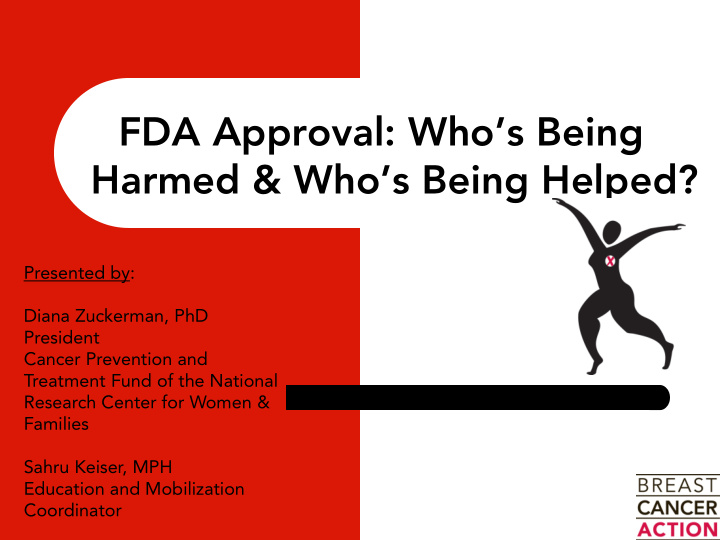



FDA Approval: Who’s Being Harmed & Who’s Being Helped? Presented by: Diana Zuckerman, PhD President Cancer Prevention and Treatment Fund of the National Research Center for Women & Families Sahru Keiser, MPH Education and Mobilization Coordinator
Agenda Overview of FDA approval process FDA approval of drugs and devices Substantially Equivalent Devices BCAction’s Position on FDA approval Ways you can get involved
Our Mission Brea east C Canc ncer er A Action n carries es the he voices es o of peo eople a e affec ected ed b by brea east canc ncer er in o n order er t to i ins nspire e and nd comp mpel el t the he cha hang nges es nec neces essary t to end end t the b he brea east c canc ncer er ep epidemi emic.
BCAction’s Strategic Priorities (1) Putting Patients First (2) Creating Healthy Environments (3) Eliminating Social Inequities
Sahru Keiser, MPH Education and Mobilization Coordinator Breast Cancer Action
Diana Zuckerman, PhD President Cancer Prevention and Treatment Fund of the National Research Center for Women & Families
FDA Approval: Who is being Harmed And Who is being Helped? Diana Zuckerman, PhD President National Research Center for Women & Families
Statistical Evidence There are 3 kinds of lies: Lies, damn Lies, and statistics
Objective Studies? Research shows that the source of funding influences study outcomes. When companies pay for studies, published results tend to reflect their financial interests
Does FDA Approval = Safety? Criteria for Approval of Prescription Drugs: Safe (over the short-term) Effective (compared to placebo) Lack of data on dangers is NOT sufficient CAVEAT: companies pay for the studies but the FDA reviews the data
FDA Approval of Drugs Safe and Effective does NOT mean Nobody will die from this drug Nobody will be harmed by this drug This drug is safe for long-term use This drug was tested on people of color This drug is more effective than other OR cheaper drugs on the market
What Medications Don’t Require FDA Approval Criteria for Dietary Supplements and Compounding Pharmacies Not tested for Safety Not proven Effective Lack of data on dangers IS sufficient
FDA Approval of Medical Devices Reasonably Safe Reasonably Effective OR Substantially Equivalent to other devices on the market – same use, similar materials-- 98% of devices are approved that way (510 k loophole)
Low Risk = Not tested
Moderate Risk (510k)
High Risk Medical Devices (pacemaker, heart, infusion pump)
Example: Radiation Shield The Axxent FlexiShield Mini shapes the radiation beam. It is a flexible pad placed on the body, made of tungsten and silicone It was cleared as substantially equivalent to a lead block attached to a tray Recalled when tungsten was found in the women’s breasts
Substantially Equivalent Devices Mammography 3D mammography machines must be proven safe and effective Other mammography machines only need evidence they are substantially equivalent to those already on the market No clinical trials required. No inspections to make sure they are made correctly
Are these substantially equivalent? = ?
Are these substantially equivalent? = ? Dow silicone sheet Vitek TMJ implants
Are these substantially equivalent? = ?
Studies for FDA are Short-term But some products are used for years, such as Tamoxifen, Hormone Replacement Therapy, Osteoporosis drugs, breast implants, or mammography Approval: Based on short-term studies, PERHAPS with requirement of later long-term studies
Breast Implants Doctors Focus on Benefits Promise: You’ll feel good about yourself Evidence: Short-term subjective studies
Implant Complications #1 - Capsular Contracture FDA booklet
Necrosis in breast cancer patient with implants for one week
Breast Implant Studies Long term data MIA: 95% of women dropped out of some post-market studies, but FDA did not enforce study requirements Implant makers focused on good news: no breast cancer or lung cancer after 7-10 years! How many smokers get lung cancer at age 27? Cancer often takes 20-30 years to develop.
Fast Track Drug Reviews Avastin was approved for Stage IV breast cancer on the basis of delay in cancer progression – not long-term patient health YEARS LATER: After approval, studies showed women taking Avastin lived for a shorter amount of time with a worse quality of life because of stroke and perforations of gastro- intestinal track
Why are standards lowered ? Lobbyists: $$$ Lobbyists: device companies in every Congressional district Lobbyists: Jobs/ innovation vs. Safety
Conclusions FDA approval does not mean safe for everyone Dietary supplements are tested only if they seem to be dangerous Drugs from compounding pharmacies are not tested for safety or effectiveness 95% of medical devices are approved without clinical trials
Conclusions When studies are required, they are short- term FDA standards of safety for devices is less strict than for drugs, and FDA approval for drugs does not always mean they are safe Let the buyer beware
Diana Zuckerman, PhD President National Research Center for Women & Families Cancer Prevention and Treatment Fund info@stopcancerfund.org www.center4research.org www.stopcancerfund.org
BCAction’s position FDA Approval Treatments should be: More effective Less toxic Less expensive
Accelerated Approval Process What is Accelerated Approval? Accelerated Approval vs. Compassionate Access Striking a balance Examples – Avastin, TDM-1
Surrogate End Points What are they? Common surrogate marker Progression free survival vs. Overall survival Limitations
What you can do Individuals – Empowered and engaged consumer/patient Systems – Collective power to influence and change regulatory systems
Review resources from presentation National Research Center for Women and Families www.center4reserach.org The Cancer Prevention and Treatment Fund www.stopcancerfund.org The National Women’s Health Network www.nwhn.org Breast Cancer Action www.bcaction.org
Join BCAction! Signup for BCActions’s newsletter and e-alert www.bcaction.org Join BCAction on Facebook www.facebook.com/BCAction Follow BCAction on Twitter twitter.com/BCAction Spread the word to friends, family, and colleagues Donate to BCAction (www.bcaction.org/donate)
Support Our Webinar Series Your support counts! If you’ve been inspired today, consider making a donation of $25 or more. www.bcaction.org/donate More questions? Contact us! Email: info@bcaction.org Toll-free: 877-2STOPBC
Breast Cancer Action Cha hallengi enging ng Assum ssumpt ptions. ns. I Inspi nspiring C ng Cha hange. nge. www.bcaction.org www.thinkbeforeyoupink.org
Recommend
More recommend